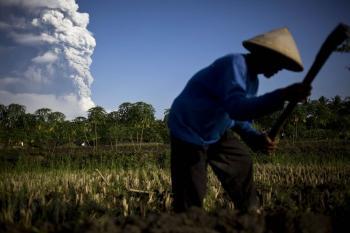YOGYAKARTA, Indonesia—Mount Merapi continues to spew gas and ash, and the Indonesian military has now deployed special forces units to monitor the volcano’s activity at close range in an effort to prevent further loss of life.
While the force of new eruptions is subsiding, on Wednesday huge ash clouds were still being coughed up by Indonesia’s most dangerous volcano.
The Indonesian military has installed some of its top special forces units—including the marines and army special forces ‘Kopasus’—to within 2 km (1.2 miles) of Mount Merapi to monitor further activity.
Pratu Mar Akmal, spokesman for Marines-1 unit, stated by email that the close monitoring operation was now going smoothly given sunny weather and a favorable wind conditions.“Therefore, monitoring can be done from very close range at about 2 kilometers from the summit of Mount Merapi,” he wrote.
Monitoring from the southeast side of the mountain, the Special Forces report that the hot volcanic ash cloud issuing from the mouth of Merapi is being carried by the wind to the southwest.
Earlier in the operation, however, there was some panic. “The wind direction changed to southeast of the personnel positioned as monitors, so the commander cried out ‘Go Down! Get off! Down!’” wrote Akmal. Then the team started moving down the mountain, he wrote.
After moving about one kilometer down the slope, the wind direction changed back toward the southwest, so the monitoring mission was again declared safe.
“We returned to Camp Kemalang, the monitoring team issuing a desperate appeal to residents feeding their flocks to be alert because the wind direction can change … threatening the life of citizens,” wrote Akmal.
In addition to the threat of hot clouds and burning lava, cold lava is also a threat to residents around Mount Merapi.
While the force of new eruptions is subsiding, on Wednesday huge ash clouds were still being coughed up by Indonesia’s most dangerous volcano.
The Indonesian military has installed some of its top special forces units—including the marines and army special forces ‘Kopasus’—to within 2 km (1.2 miles) of Mount Merapi to monitor further activity.
Pratu Mar Akmal, spokesman for Marines-1 unit, stated by email that the close monitoring operation was now going smoothly given sunny weather and a favorable wind conditions.“Therefore, monitoring can be done from very close range at about 2 kilometers from the summit of Mount Merapi,” he wrote.
Monitoring from the southeast side of the mountain, the Special Forces report that the hot volcanic ash cloud issuing from the mouth of Merapi is being carried by the wind to the southwest.
Earlier in the operation, however, there was some panic. “The wind direction changed to southeast of the personnel positioned as monitors, so the commander cried out ‘Go Down! Get off! Down!’” wrote Akmal. Then the team started moving down the mountain, he wrote.
After moving about one kilometer down the slope, the wind direction changed back toward the southwest, so the monitoring mission was again declared safe.
“We returned to Camp Kemalang, the monitoring team issuing a desperate appeal to residents feeding their flocks to be alert because the wind direction can change … threatening the life of citizens,” wrote Akmal.
In addition to the threat of hot clouds and burning lava, cold lava is also a threat to residents around Mount Merapi.





